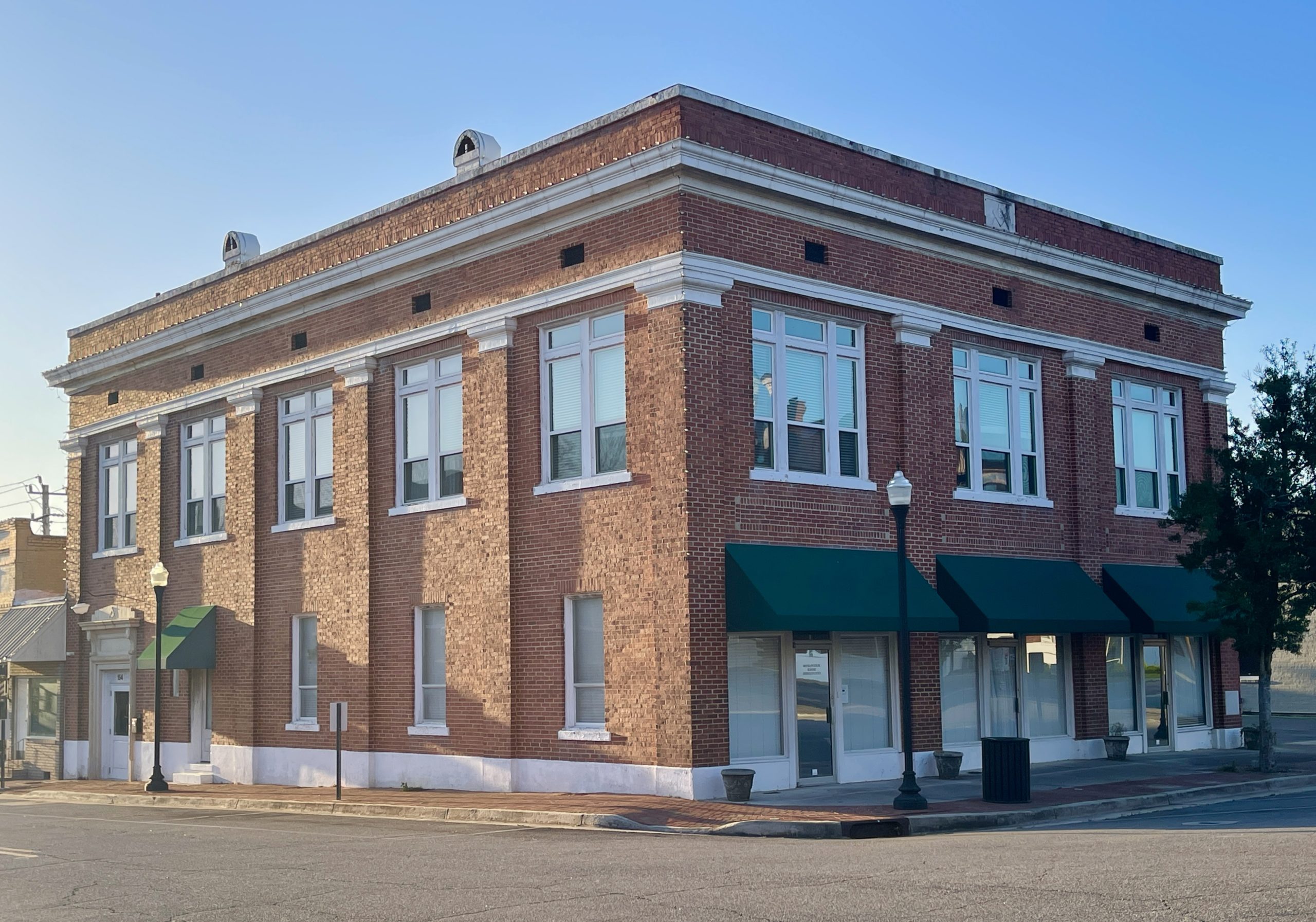

Among the commercial and governmental buildings located on Sandersville’s City Square, it may seem strange that a structure built by and dedicated to a secret fraternal order occupies such a prominent location. Although the current building was completed in 1925, this spot has been the site of a Masonic Hall since at least 1847 and possibly earlier. While membership in such fraternal orders is relatively uncommon today, in America of the 1920s, it was estimated that half of all adults belonged to one.
The details of the original Masonic Hall are unknown other than the facts it was a wooden building and burned in the Great Fire of 1855 that destroyed much of Sandersville’s central business district. From the ashes, a new City Square was born, symmetrical in shape and surrounding a large village green on which the courthouse stood. Reflecting the importance of the Masonic Order, a new two-story building—this time made of brick—was constructed and occupied in December 1856. Its facade was modeled on a Greek temple, hence it was referred to as the “Masonic Temple.” The four fluted columns across the front were made of locally-fired hand-formed bricks topped with Ionic capitals. The Masonic meeting hall was on the upper floor, accessed by an entrance from the building’s south side. The magnificent front, facing the new Square, provided entry into the ground floor which after 1909 was home to the Public Library and its collection of 7,000 volumes.
While the courthouse and most other buildings of the 1856 City Square were ordered destroyed by a vengeful federal General William T. Sherman, the Masonic Temple escaped a fiery fate, allegedly because of the general’s—or other officers’—affiliation with the Order. Even though the structure remained intact it, like most other businesses and homes in the city, was ransacked and looted by federal troops. A bit of Masonic regalia, a jeweled Worshipful Master’s apron, was stolen by a soldier from Ohio but returned to the Lodge years after the war. It currently is in the collection of the local Masonic Lodge.
In February 1921, a freak mid-winter lightning storm ignited a building down the block from the Masonic Temple. Despite efforts of the local fire brigade, the flames spread rapidly and began to engulf the iconic structure as a crowd watched helplessly from the Square. Hines Wood, a young lawyer, a Mason, and recent veteran of the trenches of World War I, volunteered to climb into the burning building in hopes of rescuing some of the of irreplaceable relics from the county’s history dating back to the Revolutionary War displayed in the Public Library and Masonic hall. Risking his life, he was able to recover a drum that had been carried by a soldier from Washington County during several battles of the Civil War. Today, that drum, with its fascinating history, is on display at the Washington County Historical Society’s museum.
Plans were immediately begun to replace the Masonic Temple with a new and even more elegant structure. The members of the Masonic Order were some of Sandersville’s most prominent and wealthiest citizens; this new building was to reflect the importance of the Order and those who belonged to it. Within four months a new set of plans had been drawn. The new “Masonic Temple,” as it was called, was to be a grandiloquent three-story structure built on the footprint of the previous one. There was a small basement, two spaces for stores on the ground floor, and a central staircase leading to the second floor with ample space for less formal gatherings and socialization. The entire third floor, some 3,500 square feet, was devoted to the meeting hall. It was—or would have been—magnificent. There was, however, one major problem.
January 1920 marked the beginning of the so-called Great Recession, a precursor to the Great Depression of the 1930s. The years of World War I and the period that immediately followed were marked by extreme monetary inflation and a stunning increase in cotton prices, the life-blood of the Southern economy. Now in 1921, cotton prices had plummeted accompanied by a drop in the value of the dollar. Once wealthy farmers, merchants, bankers, and others now faced bankruptcy and financial ruin. While the architects of the proposed new Masonic Temple had dreams of grandeur, economic reality would dictate otherwise. With the cotton economy in crisis, financing was difficult to find. The project seemed doomed until the local lodge cobbled together a series of local loans secured by promissory notes that allowed construction to start. The result, however, was not the grand edifice originally planned. Instead, February 1925 saw the dedication of a new two-story Masonic building, far different in design but in many ways similar to the Masonic Temple of 1856. The first floor was to be commercial space (occupied initially in part by the local Post Office), and the second floor a meeting hall, anterooms, and a dining area for the lodge members. As before, entry to the upstairs area was from West Haynes Street.
For the next three-quarters of a century, this new Masonic Building served as the site of the local Masonic lodge. In 2000, it was sold to William Rawlings who renovated the structure, maintaining commercial space on the ground floor and converting the former Masonic spaces upstairs to apartments. This work was done under National Park Service Guidelines and was awarded a 2005 Georgia Preservation Award for Excellent in Rehabilitation by the Georgia Trust for Historic Preservation. Its purpose renewed, the Masonic Building continues into the twenty-first century as an important part of Sandersville’s City Square.